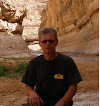01.07.2013
Boat trip : Puno - Uros Isla - Isla Taquile - Puno (the whole day long, several tens of kilometers).
An important attraction of Titicaca are the floating islands of Uros and the inhabitants of the island. The islands are named after their builders – the Uros Nation, who built them in order not to fall under the power of the Incas as the Incas expanded their empire in the 14th century. The Uroe language is now extinct, the Aymara language is spoken nowadays on the islands, because the people mixed with Aimaras over the years
.
The people of the Islands of Uros make their living on fishing and tourists at the present time. There are islands where tourists are not allowed, and there are islands where to trips of varing lengths are organized., from a few hours visit up to overnighing on the island.

Puno, Cerrito de Huajsapata - a monument dedicated to the creator of the Inca Empire, First Inca Manco Capac – is up at the hill.

Lake Titicaca. The lighter line is the reed of totora.
The islands can be visited completely on your own, as the islands and the city of Puno have quite good boat traffic which starts in the morning at 7 am and lasts until 5 pm.

In the morning it is cool and humid. The temperature is probably less than 10 degrees. Before the islands by the road there is a control post, which collects the fee of the visit from ship from companies..

Further on a boat full of tourists.


Reed houses and boats.



Tawantinsuyu island.


The islanders will demonstrate how to prepare a floating island.

The construction of an island is a continuous process and the life of an island is about 30 years.

While walking on the island one can feel springing under feet. Not so much, however, but still to realize that it is not firm ground.

Crafts sales are an important source of income for the inhabitants.




And modern life has reached here - as a solar panel catches the eye. There is no electricity transported to the islands.


Then visitors will be taken to the largest island.

Two paddlers at the nose of the boat.



There is a shop, a school and a post office. Counters with various hand work. And a gazebo. Next – a visit to the island of Taquile, it is about 35 km from Puno.

Here, tourism is a viable source of income, a number of boats at the port.
The guide makes a brief introduction - there are the 2,200 permanent residents, the islanders grow sheep. Practically there are no cats and dogs, they need a special permit to bring these animals to the island, and people live here following the ancient Inca tradition - "do not steal, do not lie, do not be lazy ". And men are engaged with knitting as well.






The central Square.



Next a local lunch is on schedule. The loacal families do the catering of the tourists in turns.

Here is an opportunity to visit the kitchen, and I can not afford to let it be said to me twice.




Looms, and a half- done belt.

The result.
Belts and Hats convey different messages. Among other issues the way one wears them will show whether one is married or not.

Lake Titicaca.
It took more than two hours for the ship to reach back to Puno. We arrived at 6 o'clock, when it was getting dark and it was already too late to start moving towards Cusco. Nature, after all, remains unseen in the dark.

Puno Cathedral in the dark.



No comments:
Post a Comment